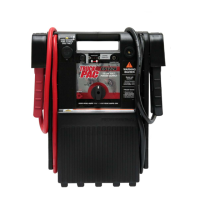
Do you have a question about the Booster TRUCK PAC ES1224 and is the answer not in the manual?
| Input Voltage | 120VAC |
|---|---|
| Type | Jump Starter |
| Voltage | 12/24 Volts |
| Battery Type | Lead-Acid, AGM |
| Output Voltage | 12/24V |
| Output Current | 10A |
| Charging Modes | Automatic |
| Safety Features | Reverse Polarity Protection, Short Circuit Protection |
General warnings about following instructions and shielding eyes for safe operation.
Warning against connecting a 12V power source to a 24V vehicle to prevent explosion.
Warning about exposure to lead and chemicals known to cause birth defects or cancer.
Never connect a 12V power source to a 24V vehicle to prevent explosion and harm.
Read all instructions before use and follow manufacturer guidelines to reduce accident risk.
Hazards associated with lead-acid batteries, including explosive gases and static electricity.
Always wear eye protection and protective clothing when working near batteries.
Store clamps in holsters to prevent short circuits and heat generation.
Exercise care in engine compartments due to moving parts and follow vehicle manual.
Have someone nearby and prepare water/soap for acid contact; seek immediate medical attention.
Avoid dropping metal tools or wearing metal jewelry near batteries to prevent sparks and burns.
Use only for lead-acid batteries; do not use for dry-cell batteries.
Never charge or jump start a frozen battery to prevent damage or explosion.
Prevent arcing by keeping clamps separated and away from metal.
Avoid unrecommended accessories; modifications void warranty and increase risk.
Use only undamaged chargers/cords; disconnect by pulling the plug.
Unit is usable in various weather but must not be submerged in water.
Do not operate with flammables like gasoline.
Handle damaged units or leaking batteries with care and contact service or recycler.
Avoid leaving the unit in a discharged state to prevent permanent battery damage.
Keep unit charged or recharge every 3 months to maintain battery life.
Details on the unit's power capabilities for vehicles and accessories, including overload protection.
Highlights the Advanced Warning System (AWS) and safety storage holsters.
Note on initial charging duration and introduction to charging methods.
Step-by-step guide for charging using the supplied wall charger, including monitoring lights.
Alternative charging method using a 12V DC outlet and extension cord, requiring manual monitoring.
Five essential checks before each use to ensure safe operation and prolong service life.
Note on optimal performance temperature and avoiding frozen batteries.
Explanation of the AWS feature that alerts operators to common jump starting mistakes.
Detailed steps for connecting the Truck PAC to the vehicle for jump starting.
Warning about matching Truck PAC voltage to vehicle voltage to prevent explosion.
Instructions for starting the vehicle, cooling the unit, and safely disconnecting.
Reasons for the AWS Detection Alarm activation, including improper connection and voltage selection.
Using the Truck PAC to save vehicle memory during battery replacement.
Using the Truck PAC with a DC to AC inverter for appliances.
Diagnosing issues with charging lights and power status.
Troubleshooting when the Truck PAC has no power after charging.
Identifying problems when an accessory causes a clicking sound or overload.
Factors affecting the number of jump starts a fully charged unit can perform.
Information on replacing the Truck PAC battery and proper recycling procedures.
Guidance on optimal temperature for using the Truck PAC and its effects.
Confirmation that only the supplied wall charger should be used for recharging.
Clarification that the unit is not 'goof-proof' and requires adherence to instructions.
Explanation of how charging and power level lights indicate the charging process.
How to know when the Truck PAC is fully charged using the TEST button.
Recommended method for testing the battery's health using a load tester.
Procedure for testing the battery's voltage under load after charging.
Step-by-step guide for safely removing the batteries from the unit.
Legal requirements for recycling and disposing of sealed lead-acid batteries.
Details of the one-year limited warranty, exclusions, and limitations.
Instructions for seeking warranty service within the first 30 days and thereafter.
Steps to register the purchase online for better service and updates.
Contact details for Clore Automotive Technical Service for inquiries.
